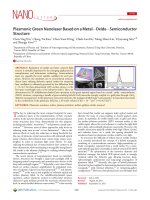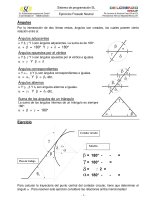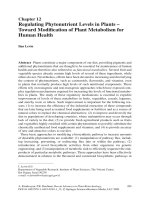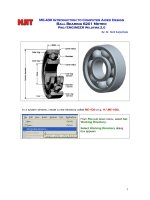Ball Milling toward Green Sythesis
Bạn đang xem bản rút gọn của tài liệu. Xem và tải ngay bản đầy đủ của tài liệu tại đây (18.36 MB, 321 trang )
Ball Milling Towards Green Synthesis
Applications, Projects, Challenges
RSC Green Chemistry
Editor-in-Chief:
Professor James Clark, Department of Chemistry, University of York, UK
Series Editors:
Professor George A Kraus, Department of Chemistry, Iowa State University,
Ames, Iowa, USA
Professor Andrzej Stankiewicz, Delft University of Technology, The Netherlands
Professor Peter Siedl, Federal University of Rio de Janeiro, Brazil
Professor Yuan Kou, Peking University, China
Titles in the Series:
1:
2:
3:
4:
5:
6:
7:
8:
9:
The Future of Glycerol: New Uses of a Versatile Raw Material
Alternative Solvents for Green Chemistry
Eco-Friendly Synthesis of Fine Chemicals
Sustainable Solutions for Modern Economies
Chemical Reactions and Processes under Flow Conditions
Radical Reactions in Aqueous Media
Aqueous Microwave Chemistry
The Future of Glycerol: 2nd Edition
Transportation Biofuels: Novel Pathways for the Production of Ethanol,
Biogas and Biodiesel
10: Alternatives to Conventional Food Processing
11: Green Trends in Insect Control
12: A Handbook of Applied Biopolymer Technology: Synthesis, Degradation
and Applications
13: Challenges in Green Analytical Chemistry
14: Advanced Oil Crop Biorefineries
15: Enantioselective Homogeneous Supported Catalysis
16: Natural Polymers Volume 1: Composites
17: Natural Polymers Volume 2: Nanocomposites
18: Integrated Forest Biorefineries
19: Sustainable Preparation of Metal Nanoparticles: Methods and
Applications
20: Alternative Solvents for Green Chemistry: 2nd Edition
21: Natural Product Extraction: Principles and Applications
22: Element Recovery and Sustainability
23: Green Materials for Sustainable Water Remediation and Treatment
24: The Economic Utilisation of Food Co-Products
25: Biomass for Sustainable Applications: Pollution Remediation and Energy
26: From C-H to C-C Bonds: Cross-Dehydrogenative-Coupling
27: Renewable Resources for Biorefineries
28: Transition Metal Catalysis in Aerobic Alcohol Oxidation
29: Green Materials from Plant Oils
30: Polyhydroxyalkanoates (PHAs) Based Blends, Composites and
Nanocomposites
31: Ball Milling Towards Green Synthesis: Applications, Projects, Challenges
How to obtain future titles on publication:
A standing order plan is available for this series. A standing order will bring
delivery of each new volume immediately on publication.
For further information please contact:
Book Sales Department, Royal Society of Chemistry, Thomas Graham House,
Science Park, Milton Road, Cambridge, CB4 0WF, UK
Telephone: ỵ44 (0)1223 420066, Fax: ỵ44 (0)1223 420247
Email:
Visit our website at www.rsc.org/books
Ball Milling Towards Green
Synthesis
Applications, Projects, Challenges
Edited by
Brindaban Ranu
University of Jadavpur, Jadavpur, Kolkata, India
Email:
Achim Stolle
University of Jena, Jena, Germany
Email:
RSC Green Chemistry No. 31
Print ISBN: 978-1-84973-945-0
PDF eISBN: 978-1-78262-198-0
ISSN: 1757-7039
A catalogue record for this book is available from the British Library
r The Royal Society of Chemistry 2015
All rights reserved
Apart from fair dealing for the purposes of research for non-commercial purposes or for
private study, criticism or review, as permitted under the Copyright, Designs and Patents
Act 1988 and the Copyright and Related Rights Regulations 2003, this publication may not
be reproduced, stored or transmitted, in any form or by any means, without the prior
permission in writing of The Royal Society of Chemistry or the copyright owner, or in the
case of reproduction in accordance with the terms of licences issued by the Copyright
Licensing Agency in the UK, or in accordance with the terms of the licences issued by the
appropriate Reproduction Rights Organization outside the UK. Enquiries concerning
reproduction outside the terms stated here should be sent to The Royal Society of
Chemistry at the address printed on this page.
The RSC is not responsible for individual opinions expressed in this work.
The authors have sought to locate owners of all reproduced material not in their own
possession and trust that no copyrights have been inadvertently infringed.
Published by The Royal Society of Chemistry,
Thomas Graham House, Science Park, Milton Road,
Cambridge CB4 0WF, UK
Registered Charity Number 207890
For further information see our web site at www.rsc.org
Foreword
Ball milling creates stress on substances. Solids break, and the resulting
particles are modified in shape and size. Defects are induced and surface
areas enlarged. Consequently, ball milling is highly relevant for various
technological fields including mineral processing, materials engineering,
and biomass degradation. In most of such applications the milling process
is used for a particle size reduction. However, the energy induced by the
mechanical treatment has other effects as well. On the molecular level, for
example, the arrangements of chemical structures can change leading to
products with altered properties. The potential of such mechanochemical
approaches and the implications in utilizing them in modern organic synthesis are nicely illustrated by the excellent contributions collected in the
book edited by Stolle and Ranu. Many of the discussed reactions are solventfree leading to ecological and economical advantages over existing technologies providing the same products. Further benefits are recognized when
comparing the energy efficiency of ball milling with other activation modes.
Apparently, ball milling can be applied in a number of bond-forming processes, and various standard organic transformations (such as oxidations,
reductions, and peptide formations) benefit from the use of this mechanochemical technique. Both low-molecular-weight compounds as well as
polymers undergo specific chemical modifications in ball mills. Surprising
observations have been made in both metal-catalyzed and organocatalytic
C–C-bond formations including asymmetric versions thereof. Liquid-assisted
grinding and kneading have proven advantageous for the preparation of coordination compounds. Being aware of the technological and process parameters is essential for achieving optimal results in synthetic transformations
performed in ball mills.
Although mechanochemical activations have already been utilized for a
long time, the advantages of applying ball mills in targeted organic synthesis
RSC Green Chemistry No. 31
Ball Milling Towards Green Synthesis: Applications, Projects, Challenges
Edited by Brindaban Ranu and Achim Stolle
r The Royal Society of Chemistry 2015
Published by the Royal Society of Chemistry, www.rsc.org
vii
viii
Foreword
has largely remained unrecognized until recently. The growing awareness of
environmental implications of chemical processes and the search for
greener solutions have led to a change, and today ball milling results are
more present in the community than ever. Gaining a deeper understanding
of the underlying mechanistic principles leading to mechanochemical activations and finding new reaction pathways resulting in products inaccessible by other means will further expand the synthetic ball milling
opportunities.
This book will initiate new thought processes and promote the implementation of ball milling as a modern synthetic technique in existing lab
structures. Experts in academia and industry as well as interested newcomers will benefit from the timely presentations collected by Stolle and
Ranu, and I congratulate both editors and authors for their stimulating
contributions.
Carsten Bolm
Aachen, Germany
Preface
During the last few years ball milling has emerged as a powerful tool in
effecting various chemical reactions in a relatively green way by reducing the
amount of solvent and operating at close to ambient temperature by application of mechanical energy. However, compared to other alternative forms
of energy such as microwave and ultrasound, ball milling is still not familiar
as a synthetic tool to a wide section of chemists and activity is limited to a
comparatively small number of groups. Thus, the objective of this book is to
create a general awareness of the importance of ball milling in chemical
transformations among all section of readers including students, teachers
and researchers. This book, entitled Ball Milling Towards Green Synthesis:
Applications, Projects, Challenges, covers the current developments in the
application of ball milling for various chemical transformations such as
carbon–carbon and carbon–heteroatom bond formation, oxidation–
reduction, organocatalytic reaction, dehydrogenative coupling, synthesis of
peptide, polymeric materials, etc. highlighting its green aspects, scope and
future prospects. This book also includes a chapter describing its origin,
technological background and challenges.
We gratefully acknowledge the co-operation from all those eminent and
active scientists who contributed chapters to this book and the support and
guidance from the staff at the Royal Society of Chemistry.
We hope this book will be able to provide basic information regarding ball
milling and its application in chemical synthesis and thus will be useful to a
wide section of chemists including students and researchers associated with
academy and industry.
Brindaban C. Ranu
Achim Stolle
RSC Green Chemistry No. 31
Ball Milling Towards Green Synthesis: Applications, Projects, Challenges
Edited by Brindaban Ranu and Achim Stolle
r The Royal Society of Chemistry 2015
Published by the Royal Society of Chemistry, www.rsc.org
ix
Contents
Chapter 1 Carbon–Heteroatom Bond Forming Reactions and
Heterocycle Synthesis under Ball Milling
Brindaban C. Ranu, Tanmay Chatterjee and
Nirmalya Mukherjee
1.1
1.2
Introduction
Carbon–Heteroatom Bond Forming Reactions under
Ball Milling
1.2.1 C–N Bond Forming Reactions
1.2.2 C–O Bond Forming Reactions
1.2.3 C–X (X ¼ F, Cl, I, SCN, OAc etc.) Bond
Forming Reaction
1.2.4 C–X (X ¼ S, Se and Te) Bond Forming Reactions
1.3 Synthesis of Heterocycles
1.3.1 Nitrogen-containing Heterocycles
1.3.2 Oxygen-containing Heterocycles
1.3.3 Nitrogen–Oxygen-containing Heterocycles
1.3.4 Boron-containing Heterocycles
1.3.5 Fullerene Chemistry
1.3.6 Macrocycle Formation
1.4 Conclusion
References
Chapter 2 Carbon–Carbon Bond Forming by Ball Milling
Katharina Jacob, Robert Schmidt and Achim Stolle
2.1
2.2
Introduction
Cross-coupling Reactions
2.2.1 Sonogashira Cross-coupling
RSC Green Chemistry No. 31
Ball Milling Towards Green Synthesis: Applications, Projects, Challenges
Edited by Brindaban Ranu and Achim Stolle
r The Royal Society of Chemistry 2015
Published by the Royal Society of Chemistry, www.rsc.org
xi
1
1
2
2
10
11
12
13
13
18
22
23
25
27
31
31
34
34
35
35
xii
Contents
2.2.2 Suzuki–Miyaura Cross-coupling
2.2.3 Mizoroki–Heck Reaction
2.3 Homo-coupling Reactions
2.3.1 Homo-coupling of Phenols
2.3.2 Glaser Coupling
2.3.3 Homo-coupling of Boronic Acids
2.4 Miscellaneous
2.5 Carbon–Carbon Bond Formation by Condensation
Reactions
2.5.1 Aldol-type Reactions
2.5.2 Knoevenagel Condensation
2.5.3 Michael Addition
2.5.4 Baylis–Hillman Reaction
2.5.5 Wittig Reaction
2.6 Diels–Alder Reaction
2.7 Grignard Reaction
2.8 McMurry Reactions
2.9 Further Miscellaneous Reactions
2.10 Summary
Abbreviations
References
Chapter 3 Oxidation and Reduction by Solid Oxidants and Reducing
Agents using Ball-Milling
Giancarlo Cravotto and Emanuela Calcio Gaudino
3.1 Introduction
3.2 Mechanochemical Oxidation
3.3 Mechanochemical Reduction
3.4 Conclusion
References
Chapter 4 Asymmetric Organocatalytic Reactions under Ball
Milling
Elizabeth Machuca and Eusebio Juaristi
4.1
4.2
Introduction
Asymmetric Organocatalysis and the Ball Milling
Technique
4.2.1 Asymmetric Aldol Reaction
4.2.2 Asymmetric Michael Addition
4.2.3 Asymmetric Morita–Baylis–Hillman (MBH)
Reaction
4.2.4 Asymmetric Alkylation of Imines
4.2.5 Desymmetrization of Aromatic Diamines and
meso Anhydrides by Mechanochemistry
36
39
40
40
41
42
42
43
43
44
46
49
49
51
52
53
53
54
54
55
58
58
60
73
78
79
81
81
82
82
85
89
89
89
Contents
xiii
4.3 Closing Remarks
Acknowledgements
References
Chapter 5 Cross Dehydrogenative Coupling Reactions by Ball
Milling
Jingbo Yu, Zhijiang Jiang and Weike Su
5.1
5.2
Introduction
Cross Dehydrogenative Coupling Reactions under
Ball Milling Conditions Applied to the Synthesis of
Functionalized Tetrahydroisoquinolines
5.2.1 C(sp3)–C(sp3) Coupling Reaction
5.2.2 C(sp3)–C(sp) Coupling Reaction
5.2.3 C(sp3)–Aryl-C(sp2) Coupling Reaction
5.2.4 Milling Parameters
5.3 Asymmetric Cross-dehydrogenative Coupling
Reaction by Ball Milling
5.3.1 Asymmetric Alkynylation of Prochiral
C(sp3)–H Bonds
5.3.2 Effects on Enantioselectivity
5.4 Summary and Outlook
References
Chapter 6 Amino Acids and Peptides in Ball Milling
Thomas-Xavier Me´tro, Evelina Colacino, Jean Martinez and
Fre´de´ric Lamaty
6.1
6.2
Introduction
Mechanochemical Synthesis and Derivatization of
Amino Acids
6.2.1 Synthesis of Amino Acid Derivatives
6.2.2 Oxidation Reactions
6.2.3 Asymmetric Synthesis of Amino Acids
6.2.4 Synthesis of Unsaturated Amino Acids
6.2.5 Synthesis of Protected Amino Acids
6.3 Mechanosynthesis of Peptides
6.3.1 Synthesis of Di- and Tripeptides
6.3.2 Scale-up of Peptide Synthesis
6.3.3 Synthesis of a,b- and b,b-Dipeptides
6.3.4 Synthesis of Peptides with a Longer
Amino Acid Sequence
6.4 Conclusion
References
90
91
91
96
96
97
98
98
101
103
106
107
109
111
111
114
114
117
117
117
119
121
123
130
130
131
133
137
148
148
xiv
Contents
Chapter 7 Ball-milling Mechanochemical Synthesis of
Coordination Bonds: Discrete Units, Polymers and
Porous Materials
Tomislav Frisˇˇcic´
7.1
7.2
Introduction
Benefits of Mechanochemical Synthesis in making
Coordination Bonds
7.3 Methods for the Mechanosynthesis of Coordination
Bonds
7.3.1 Neat Grinding
7.3.2 Grinding–Annealing
7.3.3 Liquid-assisted Grinding and
Kneading
7.3.4 Ion- and Liquid-assisted Grinding (ILAG)
7.4 Characterization of Mechanochemical Products
7.5 Synthetic Strategies
7.5.1 Ligand Addition Reactions
7.5.2 Ligand Exchange
7.5.3 Acid–Base Reactions
7.5.4 Synthesis of Coordination Polymers and
MOFs from Metal Oxides and Carbonates
7.5.5 Mechanochemical Dehydration
7.5.6 One-pot Multi-component Strategies
7.6 Functional Metal–Organic Materials
7.6.1 Microporous Metal–Organic Frameworks
7.6.2 Pharmaceutical Derivatives and
Metallodrugs
7.6.3 Luminescent Materials
7.7 New Properties and Synthetic Opportunities arising
from Mechanochemical Synthesis of Metal–Organic
Materials
7.7.1 Structural Dynamics under
Mechanochemical Conditions
7.7.2 Synthesis of Solid Solutions
7.7.3 Binding of Carbon Dioxide upon
Mechanochemical Treatment
7.8 Mechanistic Studies of Mechanochemical
MOF Synthesis
7.8.1 Stepwise Analysis
7.8.2 In Situ and Real-time Studies
7.8.3 Electron Microscopy
7.9 Outlook
Abbreviations
Acknowledgements
References
151
151
152
155
155
156
156
159
160
161
161
163
164
165
167
167
169
169
171
174
175
175
177
178
178
178
180
183
183
184
185
185
Contents
xv
Chapter 8 A Chromatography-free Method for the Isolation of
Products from Mechanochemical Reactions
James Mack
8.1
8.2
Introduction
Polymer Supported Resins: Advantages and
Disadvantages
8.3 Mechanochemical Activation of Polymer Resins
8.4 Conclusion
References
Chapter 9 Ball-milling Promoted Chemical Bonding between
Cellulose and Plastics
Takahiro Hirotsu, Takashi Endo and Myco Umemura
9.1
9.2
Introduction
Intra- and Intermolecular Interactions of Cellulose
9.2.1 Conformation of Cello-oligosaccharides
9.2.2 Aggregations of Cello-oligosaccharides
9.2.3 Polymorphism of Cellulose
9.3 Activation of Cellulose by Ball Milling
9.3.1 Micro-pulverization of Native Cellulose
9.3.2 Characteristics of Micro-pulverized Cellulose
9.4 Grafting of Maleic Anhydride onto Polyolefins by
Ball Milling
9.4.1 Free-radical Grafting of Maleic Anhydride
onto Polyolefins
9.4.2 Mechanochemical Grafting of Maleic
Anhydride onto Polypropylene
9.5 Novel Composites of Cellulose and Plastics by
Ball Milling
9.5.1 Compatibilization of Cellulose with
Poly(ethylene glycol)
9.5.2 Composite of Cellulose and Maleated
Polyolefin
9.6 Concluding Remarks
Acknowledgements
References
Chapter 10 Technical Implications of Organic Syntheses in Ball Mills
Achim Stolle
10.1
Introduction
10.1.1 Mechanochemistry
10.1.2 Using Mortar and Pestle for Organic
Syntheses
190
190
192
196
201
201
203
203
204
204
207
211
214
214
218
221
221
224
229
229
231
238
238
239
241
241
242
243
xvi
Contents
10.1.3 Ball Mills
10.1.4 Scope of this Chapter
10.2 Ball Mills as Reactors in Organic Synthesis
10.3 Technological Parameters
10.3.1 Type of Ball Mill
10.3.2 Grinding Material
10.3.3 Number of Milling Balls
10.3.4 Size of Milling Balls
10.3.5 Filling Degree
10.4 Process Parameters
10.4.1 Operating Frequency
10.4.2 Milling Time
10.4.3 Combined Assessment of Frequency
and Time
10.4.4 Reaction Temperature
10.5 Energy Efficiency and Comparison to
Other Methods
10.6 Conclusion and Outlook
Abbreviations and Symbols
References
Subject Index
243
244
245
246
246
251
253
255
258
260
260
262
263
266
268
270
271
272
277
CHAPTER 1
Carbon–Heteroatom Bond
Forming Reactions and
Heterocycle Synthesis under
Ball Milling
BRINDABAN C. RANU,* TANMAY CHATTERJEE AND
NIRMALYA MUKHERJEE
Department of Organic Chemistry, Indian Association for the Cultivation
of Science, Jadavpur, Kolkata 700032, India
*Email: ;
1.1 Introduction
Chemical transformations involving mechanochemical (grinding) reactions
using a mortar and pestle were initiated long ago during the early stage of
evolution of chemistry. But due to variable and relatively low grinding
strength and speed, limited chemical reactions were successfully carried out
by grinding. To overcome this limitation, a mixer/shaker mill or a planetary
mill1 has been developed and these devices provide much higher energy and
are more reliable than hand grinding. Mixing in such a mill is generally
referred to as ‘‘milling’’. Mechanical grinding in these mills is aided by the
milling balls and hence it is called ball milling. Mechanochemistry using
ball milling has received intense attention in organic synthesis in recent
decades and is now a fast growing branch. Mechanochemical reactions in a
ball mill depend on several parameters like milling frequency, milling time,
RSC Green Chemistry No. 31
Ball Milling Towards Green Synthesis: Applications, Projects, Challenges
Edited by Brindaban Ranu and Achim Stolle
r The Royal Society of Chemistry 2015
Published by the Royal Society of Chemistry, www.rsc.org
1
2
Chapter 1
size and number of milling balls, and the material of milling balls and beakers. The first two have been found to be the most important parameters.1
Basically two types of ball mills have been frequently used to perform organic
transformations, i.e. mixer mill (MM) and planetary mill (PM) (for further
details the reader is referred to Chapter 10).
The present chapter covers reactions involving carbon–heteroatom (C–N,
C–O, C–S, C–Cl, C–Br, etc.) bond formation and synthesis of heterocycles
under ball milling.
1.2 Carbon–Heteroatom Bond Forming Reactions
under Ball Milling
1.2.1
C–N Bond Forming Reactions
Kaupp and co-workers have reported the quantitative formation of imines
by ball milling a stoichiometric mixture of aldehyde and amine in less than
30 min (Scheme 1.1).2,3
All the reactions were carried out below 0 1C except for the condensations
of 4-nitroaniline with 4-hydroxybenzaldehyde and 4-nitrobenzaldehyde,
which were performed at 60 and 80 1C, respectively.
The same group also investigated the solid-state reactions of hydrazine–
hydroquinone (1 : 1 complex) and of hydrazine hydrochloride with solid
aldehyde, ketone, carboxylic acid, thiohydantoin and 4-nitrophenyl isothiocyanate and found that only the hydrazine hydroquinone complex
provides quantitative addition, condensation, ring opening and ring closure
(Schemes 1.2 and 1.3).4
NH2
CHO
+
Scheme 1.1
2) drying under
vacuum at 80 °C
R2
R1
1) MM (30 Hz)
-20 °C to 80 °C
0.5-12 h
R2
N
R1
100%
Imine formation under mechanical milling.
OH
O
2 R1
Ball-milling
NH2-NH2 .
+
N N
R1
R1
-2H2O
R2
R2 R2
OH
100%
Some selected examples:
N N
N N
OH
HO
H
H
N N
H
Scheme 1.2
H
H
N N
N(CH3)2
(H3C)2N
Cl
Cl
H
O 2N
NO2
Synthesis of azines from the solid state reaction between aldehyde or
ketone and hydrazine–hydroquinone complex in a ball mill.
Carbon–Heteroatom Bond Forming Reactions
3
OH
H
N
N C S
Ball-milling
-H2O
+ NH2-NH2 .
O2N
NHNH2
S
O 2N
OH
O
OH
H
N
N
H
S
Ball-milling
-H2O
S + NH2-NH2 .
OH
OH
O
HOOC
O
OH
+ NH2-NH2 .
Ball-milling
-2H2O
O
NHNH2
O
NH
N
COOH
O
NH
N
Ball-milling
-2H2O
COOH + NH2-NH2 .
OH
Scheme 1.3
N
H
O
OH
OH
Ph
H2N
Ph
Quantitative C–N bond forming reactions via condensation, ring opening and ring closure under ball milling.
Naimi-Jamal, Kaupp and co-workers employed ‘‘kneading ball-milling’’ for
the stoichiometric quantitative preparation of synthetically versatile 2,4dinitrophenylhydrazones from low-melting aldehydes and ketones.5 Owing
to the potential explosive nature of dry 2,4-dinitrophenylhydrazine, 50 wt%
deionized water was added to wet the crystals. Water was used as an auxiliary
to minimize the risk of explosive destruction. The stoichiometric reaction of
2,4-dinitrophenylhydrazine with aldehydes or ketones occurred rapidly in
the kneading ball mill at 25–70 1C for 10–20 min, giving the desired
hydrazones in 58–100% yields (Scheme 1.4). When these reactions are
performed in solution, strong acid catalysts are required.6 However, they
occur much faster in the kneading ball mill in the absence of catalyst.
Similarly, aldehydes and ketones were stoichiometrically ball-milled with
hydroxylamine hydrochloride at 25–140 1C for 10–120 min to provide the
hydrated oxime salts in sticky form, which were then treated with a base to
obtain the oximes in 75–100% yields (Scheme 1.5).5 NaCl in water and CO2
from carbonate were found to be the only wastes produced. Aldehydes were
found to be more reactive than ketones towards hydroxylamine. The difference in reactivity of aldehydes and ketones can be utilized as a versatile
method for selective protection of an aldehyde by oximation in the presence
of a ketone.
Benzoylhydrazones were also obtained, by ball-milling benzhydrazide and
solid aldehydes in a molar ratio of 1 : 1 for 1 h at 25–30 1C. However,
the reaction of benzhydrazide with isatin required 3 h of ball milling for
completion (Scheme 1.6).7
Liquid assisted grinding (LAG)8 has been applied for the synthesis of
imine from 5-aminosalicylic acid and vanillin or 2-hydroxy-1- naphthaldehyde in a ball mill for 5–30 min in the presence of a small amount of EtOH
or EtOH–NEt3 (Scheme 1.7).
4
Chapter 1
NO2
O
R1
NHNH2
NO2
+
Kneading
ball-milling
25 °-70 °C,
10-20 min, -H2O
R2
NNH
R1
R2
NO2
58-100%
NO2
Some selected examples:
NO2
NNH
NNH
NNH
NO2
H
NO2
MeO
NNH
NO2
Scheme 1.5
NNH
NO2
NO2
Me
O2N
NO2
100%
58%
84%
R1
NO2
Me
Me
O
100%
NO2
NO2
Scheme 1.4
O 2N
100%
NO2
H
H
100%
NNH
NO2
NO2
Kneading ball-milling for the preparation of 2,4-dinitrophenylhydrazones.
Kneading
Ball-milling
(20-25 Hz)
+ NH2OH.HCl
25-140 °C,
R2
10-120 min
NOH
R1
R2
.HCl.H2O
NOH
aq. NaHCO3
R1
+ NaCl
R2
75-100% overall yield
Solvent-free kneading ball-milling of aldehyde or ketone with hydroxylamine hydrochloride.
R1
R2
OHC
O
NHNH2
O
NHN
MM (30 Hz),
1h, 100%
O
R1
R2
O
N
H
MM (30 Hz),
3h, 100%
Scheme 1.6
NHN
O
NH
Benzoylhydrazone formation by ball milling.
EtOH or EtOH-NEt3
LAG
NH2
+
HOOC
OH
Scheme 1.7
O
R-CHO
MM (25 Hz), rt
5-30 min
N
R
HOOC
OH
100%
Liquid assisted grinding (LAG) in a mechanical mill to form imine.
Carbon–Heteroatom Bond Forming Reactions
O
Ar1
+
H
Ar2 NH2
5
O
Oxone, MgSO4
ball-milling (30 Hz)
rt, 90 min
Ar2
N
H
38-78%
Ar1
Some selected examples:
CH3
O
N
H
O2N
38%
Br
O
N
H
Cl
Scheme 1.8
N
H
NO2
78%
O
Cl
CH3
O
65%
S
HN
42%
CH3
Direct oxidative amidation of aldehydes with anilines.
Wang and Gao have reported direct oxidative amidation of aldehydes with
anilines under ball milling (Scheme 1.8).9 Oxone was used as an effective
oxidant for the transformation of aldehydes into amides. Other oxidants like
K2S2O8 and I2 failed to initiate the oxidative amidation.
MgSO4 was found to be the best dehydrating agent for removing the water
formed in the reaction. In addition, when the oxidative amidation reaction
was performed in organic solvents such as acetonitrile or toluene, under
identical reaction conditions, the yield of the corresponding product was
comparatively lower than the reaction under solvent-free condition in a ball
mill. Anilines bearing electron-donating and electron-withdrawing groups
underwent facile reaction with aldehydes bearing electron-withdrawing
groups only. Reactions with aldehydes containing electron-donating groups
were unsuccessful, indicating the importance of the electronic character of
aldehydes. Aliphatic anilines were also inert under the reaction conditions.
The replacement of an aldehyde by the corresponding carboxylic acid did not
afford the amides, thereby discarding the possibility of oxidation of aldehyde
to carboxylic acid by Oxone followed by reaction with aniline to give amide.
A tentative mechanism for the amidation reaction of aldehydes with anilines based on the above results was proposed (Scheme 1.9). This direct
oxidative amidation reaction may proceed via two pathways. In pathway A,
the interaction of an aldehyde and aniline produces imine readily, which is
then oxidized by Oxone to generate oxaziridine 1 as the key intermediate.
Rearrangement of oxaziridine to amide is known for both photochemical
and thermal reactions.10 Initial cleavage of the N–O bond followed by migration of the substituent (hydrogen) trans to the nitrogen lone pair results
in the formation of amide 2. In pathway B, nucleophilic addition of aniline
to aldehyde produces carbinolamine intermediate 3, which is then oxidized
by Oxone to form the amide. Even though control experiments showed that
imine could be employed to perform the amidation directly, the exact
mechanism of this reaction remains obscure and both pathways could be
operational.
6
Chapter 1
1
Path A Ar
O
Ar1
H
+ Ar2 NH2
H
Ar1
O ..
N
Ar2
H
[O]
N
Ar2
O
1
OH
Path B
Ar1
N
H
Ar1
[O]
N
H
2
Ar2
Ar2
3
Scheme 1.9
Possible pathway for the direct oxidative amidation of aldehydes with
anilines.
NCX
NCY
H
N
NH2
X
NH2
R1
ball-milling
X
N
NH H
R1
Y
R2
N
NH H
R2
R1
ball-milling
H 2N
ortho or para
X, Y = S or O
R1 , R 2 = H, Cl, NO2 , OCH 3
H
N
78-99%
Some selected examples:
S
S
S
H3 CO
NH
HN
Cl
O2 N
NH
NH
HN
99%
Scheme 1.10
S
O
NH HN
H 3CO
HN
Cl
97%
99%
S
S
NH HN
NH HN
O
NH HN
O2 N
NH
HN
99%
Synthesis of symmetrical and non-symmetrical phenylenediamine(thio)urea derivatives by ball milling.
A new methodology has been developed for the desymmetrization of
aromatic diamines to non-symmetrical thiourea derivatives by clickmechanochemistry in a ball mill.11 Phenylenediamines (o-, p-) were desymmetrized through a one-pot mechanochemical click reaction sequence to
furnish mono- and bis(thio)ureas or mixed thiourea–ureas (Scheme 1.10).
o-Phenylenediamine reacted selectively with either one or two equivalents
of phenyl isothiocyanate to yield the non-symmetrical amino-thiourea or the
symmetrical bis-thiourea in 95% and 499% yields respectively. The excellent
control of the stoichiometric composition of the product in mechanochemical click-thiourea coupling demonstrates that it provides a facile and
clean one-pot route to desymmetrization of aromatic diamines, and to the
synthesis of symmetrical and non-symmetrical bis-(thio)ureas that are obtained in poor yields in solution.12
A chemoselective C–N bond formation has been achieved by the acylation
of primary aliphatic amines using a vibrational ball mill in 10 min (120 min
for aromatic amines). Azobenzene functionalized esters were employed to
react with various amines (primary and secondary) in presence of a base,
Carbon–Heteroatom Bond Forming Reactions
7
N,N-dimethyl-4-aminopyridine (DMAP), under vibrational ball-milling to
synthesize the corresponding amides (Scheme 1.11).13
Jin et al. have reported an efficient solvent and catalyst-free aza-Michael
addition of chalcone to amine under the high-speed vibration ball-milling in
a short reaction time (Scheme 1.12).14 In general, excellent yields were obtained, eliminating the usual side reactions. It was also observed that the
yields of the corresponding products obtained using anilines were lower
compared to those using benzyl amine or piperidine.
O
R1
O
O
DMAP (1.5 equiv.)
O
+
N
R2 NH2
O
R2
N
H
65-94%
R1
vibration ball-milling
(28 Hz)
10 min
Some selected examples:
O
O
N
H
N
N
N
N
H
N
65%
90%
OMe
O
N
N
N
Me
N
H
N
HO
77%
72%
Scheme 1.11
OH
O
N
H
C–N bond forming reaction of propargylamine with N-hydroxysuccinimidyl p-(phenylazo)benzoate under ball milling.
R3
O
+
R1
R2
HSVM, 30 Hz
R3 NH2 Catalyst-free
R1
25 min.
NH O
R2
47-99%
Some selected examples:
NH O
NH O
Br
F3C
99%
90%
NH O
OCH3 O2N
OCH3
90%
Cl
H 3C
H3CO
NO2
Scheme 1.12
NH O
NH O
NH O
59%
52%
47%
N
O
89%
OCH3
Aza-Michael addition of different amines to chalcones under HSVM
conditions.
8
Chapter 1
OH O
O
O
O
NH2
N
H
99-100%
Scheme 1.13
R
O
O
ball-milling (30 Hz)
o
rt-70 C, 1 h
R2
O
R1
1
R
R2
O
R
ball-milling (30 Hz)
rt, 30 min
R2
O
R
R1
R1
N
H
100%
Enamino ketone synthesis under ball milling.
O
O
R
Scheme 1.14
R2
1
+
R2 NH2
MM (30 Hz)
rt, 0.5-2 h, 61-97%
R2
NH
O
R1
Synthesis of enamino ketone and ester using aliphatic amine under
ball milling.
Kaupp’s group has reported quantitative synthesis of enamino ketones by
the reaction of cyclic 1,3-dicarbonyl compounds such as 1,3-cyclohexanedione,
dimedone and dehydroacetic acid with aniline derivatives without any
catalyst under ball milling within 1 h, followed by drying at 0.01 bar at 80 1C
(Scheme 1.13).7
Li and co-workers have reported the mechanochemical reaction of
aliphatic primary amines with acyclic 1,3-dicarbonyl compounds such as 1,3pentadione and ethyl acetoacetate in the absence of catalyst and solvent
(Scheme 1.14).15 A series of enamino ketones and esters were obtained in
61–97% yields by ball milling the mixtures of amines and 1,3-dicarbonyl
compounds in a ratio of 1 : 1 in a mixer mill at 30 Hz for 0.5–2 h.
Stolle et al. have developed a solvent-free methodology for the synthesis of
enamines by the addition of amines to dialkyl acetylene dicarboxylates or
alkyl propiolates using a planetary ball mill at 800 rpm (13.3 Hz)
(Scheme 1.15).16 Fused quartz sand (SiO2) was used as inert grinding
auxiliary to facilitate the energy entry in the presence of liquid substrates
by adsorbing them on the surface.17 Significantly, reactions with several
anilines and secondary alkyl amines were complete within five minutes with
excellent yield of products. Besides the (E-/Z)-isomers, no other product was
formed. Interestingly, addition of aniline or p-toluidine to dialkyl acetylene
dicarboxylate produced the (E)-enamine as the major product whereas
addition of the same amine to alkyl propiolate produces the (Z)-enamine as
the major product.
Lamaty and co-workers reported the condensation of aldehydes with
equimolar amounts of N-substituted hydroxylamines in a ball mill at a
frequency of 30 Hz for 0.5–2 h to obtain various C-aryl and C-alkyl nitrones in
71–100% yields (Scheme 1.16).18 Significantly, reactions were performed in
the presence of air and moisture and the products were obtained pure.
Though urea is very unreactive toward alkylation, the reaction of urea with
4-bromobenzyl bromide under mechanical milling in the presence of NaOH
produced di(4-bromobenzyl)urea with 41% conversion for a total milling
time of 34 h (Scheme 1.17).19









